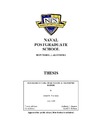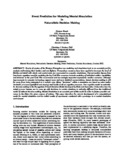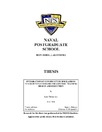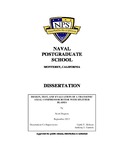FLUID-STRUCTURE ANALYSIS OF A TRANSONIC ROTOR
| dc.contributor.advisor | Hobson, Garth V. | |
| dc.contributor.advisor | Gannon, Anthony J. | |
| dc.contributor.author | Thornton, Grant D. | |
| dc.date.accessioned | 2019-08-08T23:48:30Z | |
| dc.date.available | 2019-08-08T23:48:30Z | |
| dc.date.issued | 2019-06 | |
| dc.identifier.uri | https://hdl.handle.net/10945/62704 | |
| dc.description.abstract | This study developed and applied a 2-way fluid-structure interaction model to increase fidelity in numerical simulations of the Naval Postgraduate School Military Fan. The Naval Postgraduate School Military Fan is an existing transonic-rotor geometry undergoing test and evaluation using the Turbopropulsion Lab's Transonic-Compressor Rig. A fluid solution using ANSYS CFX was developed and coupled with an ANSYS Mechanical static-structural solution of the rotor blade to model the hot shape of the rotor. Cold-shape simulations were conducted for 0.42% average blade-height (0.381 mm) and 1.41% average blade-height (1.27 mm) tip-gap configurations, and hot-shape simulations were conducted for the latter configuration. Performance predictions in terms of total pressure ratios and isentropic efficiencies were compared for cold- and hot-shape analyses and measured for fidelity against experimental data. Hot-shape analyses consistently improved modeling fidelity as compared to cold-shape analyses by allowing for increased mass-flow rates due to radial growth and untwist of the rotor blades at speed. Flow features associated with the transonic regime were identified and discussed for both cold and hot analyses. With the developed experimentally verified modeling procedure, CFD predictions may be conducted for alternate configurations of the evaluated rotor or for other transonic rotor geometries as a supplement to experimental data acquisition. | en_US |
| dc.description.sponsorship | Office of Naval Research | en_US |
| dc.description.uri | http://archive.org/details/fluidstructurean1094562704 | |
| dc.publisher | Monterey, CA; Naval Postgraduate School | en_US |
| dc.rights | This publication is a work of the U.S. Government as defined in Title 17, United States Code, Section 101. Copyright protection is not available for this work in the United States. | en_US |
| dc.title | FLUID-STRUCTURE ANALYSIS OF A TRANSONIC ROTOR | en_US |
| dc.type | Thesis | en_US |
| dc.contributor.department | Mechanical and Aerospace Engineering (MAE) | |
| dc.subject.author | transonic rotor | en_US |
| dc.subject.author | CFD | en_US |
| dc.subject.author | CFX | en_US |
| dc.subject.author | fluid-structure interaction | en_US |
| dc.subject.author | tip-gap effects | en_US |
| dc.subject.author | tip-leakage vortex | en_US |
| dc.description.recognition | Outstanding Thesis | en_US |
| dc.description.service | Ensign, United States Navy | en_US |
| etd.thesisdegree.name | Master of Science in Engineering Science (Aerospace Engineering) | en_US |
| etd.thesisdegree.level | Masters | en_US |
| etd.thesisdegree.discipline | Engineering Science (Aerospace Engineering) | en_US |
| etd.thesisdegree.grantor | Naval Postgraduate School | en_US |
| dc.identifier.thesisid | 32092 | |
| dc.description.distributionstatement | Approved for public release; distribution is unlimited. |
Files in this item
This item appears in the following Collection(s)
-
1. Thesis and Dissertation Collection, all items
Publicly releasable NPS Theses, Dissertations, MBA Professional Reports, Joint Applied Projects, Systems Engineering Project Reports and other NPS degree-earning written works. -
2. NPS Outstanding Theses and Dissertations





